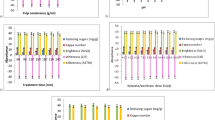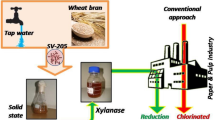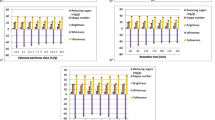Abstract
Thermo- and alkali-stable xylanases produced from Thielaviopsis basicola (MTCC-1467) on low-cost carbon source like rice straw were evaluated for their potential application in biobleaching of wood kraft pulp. Enzyme treatment at retention time of 240 min with 20 IU/gm of dried pulp resulted in ~85.2 % of reduction in kappa number. When compared to control, 110.8, 93, and 72.2 % of enhancement in brightness (percent International Organization of Standardization), whiteness, and fluorescence, respectively, were observed for enzyme-treated pulp. Spectroscopic analysis showed significant release of chromophoric compounds from enzyme-treated pulp. Furthermore, scanning electron microscope studies of unbleached and enzyme bleached pulp revealed the effectiveness of enzymatic treatment. The enzyme-treated pulp subjected to later stages of chemical bleaching resulted in 16 % decrease in chlorine consumption along with considerable reduction in chemical oxygen demand percentage (14.5 %) level of effluent. Various pulp properties like fiber length, fiber width, burst strength, burst index, tear strength, tear index, tensile strength, and breaking length were also significantly improved after enzyme treatment when compared to control.







Similar content being viewed by others
References
Garg, A. P., Roberts, J. C., & McCarthy, A. J. (1998). Bleach boosting effect of cellulase-free xylanase of Streptomyces thermoviolaceus and its comparison with two commercial enzyme preparations on birchwood kraft pulp. Enzyme and Microbial Technology, 22, 594–598.
Georis, J., Giannotta, F., De Buyl, E., Granier, B., & Frere, J. M. (2000). Purification and properties of three endo-1,4-xylanase produced by Streptomyces sp. strain S38 which differ in their ability to enhance the bleaching of kraft pulps. Enzyme and Microbial Technology, 26, 178–186.
Hong, Q., Shin, N. H., & Chang, H. (1989). Effect of oxygen extraction on organic chlorine contents in bleach plant effluents. Tappi Journal, 72, 157–161.
Christov, L. P., Szakacs, G., & Balakrishnan, H. (1999). Production, partial characterization, and use of fungal cellulase-free xylanase in pulp bleaching. Process Biochemistry, 34, 511–517.
Gupta, S., Bhushan, B., & Hoondal, G. S. (2000). Isolation, purification and characterization of xylanase from Staphylococcus sp. SG-13 and its application in biobleaching of kraft pulp. Journal of Applied Microbiology, 88, 325–334.
Saleem, M., Tabassum, M. R., Yasmin, R., & Imran, M. (2009). Potential of xylanase from thermophilic Bacillus sp. XTR-10 in biobleaching of wood kraf t pulp. International Biodeterioration & Biodegradation, 63, 1119–1124.
Uma, A., Deb, J. K., Baby Rani, G., Prameela Devi, Y., & Laxminarasu, M. (2008). Characterization and partial purification of xylanases from Thielaviopsis basicola. Technology Spectrum Journal, 2(2), 63–68.
Battan, B., Sharma, J., Dhiman, S. S., & Kuhad, R. C. (2007). Enhanced production of cellulase-free thermostable xylanase by Bacillus pumilus ASH and its potential application in paper industry. Enzyme and Microbial Technology, 41, 733–739.
Viikari, L., Ranua, M., Kantelinen, A., Linko, M., & Sundquist, J. (1987). Application of enzymes in bleaching. Fourth international symposium on wood and pulping chemistry, 1, 151–154.
Eriksson, K. E. L. (1990). Biotechnology in the pulp and the paper industry. Wood Science and Technology, 24, 79–101.
Beg, Q. K., Bhushan, B., Kapoor, M., & Hoondal, G. S. (2000). Enhanced production of a thermostable xylanase from Streptomyces sp. QG-11-3 and its application in biobleaching of eucalyptus kraft pulp. Enzyme and Microbial Technology, 27, 459–466.
Park, Y., Kang, S., Lee, J., Hong, S., & Kim, S. (2002). Xylanase production in solid state fermentation by Aspergillus niger mutant using statistical experimental designs. Applied Microbiology and Biotechnology, 58(6), 761–766. doi:10.1007/s00253-002-0965-0.
Seyis, I., & Aksoz, N. (2005). Xylanase production from Trichoderma harzianum 1073 D3 with alternative carbon and nitrogen sources. Food Technology and Biotechnology, 43(1), 37–40.
Ghosh, V. K., & Deb, J. K. (1988). Production and characterization of xylanase from Thielaviopsis basicola. Applied Microbiology and Biotechnology, 29, 44–47.
Miller, G. L. (1959). Use of dinitrosalicylic acid reagent for determination of reducing sugar. Analytical Chemistry, 31, 426–428.
Atlanta, G. A. (1996). TAPPI test methods. Technical Association of the Pulp and Paper Industry. TAPPI Press: New York.
Bajpai, P., Bhardwaj, N. K., Bajpai, P. K., & Jauhari, B. M. (1994). The impact of xylanases on bleaching of eucalyptus kraft pulp. Journal of Biotechnology, 38, 1–6.
Coman, G., & Bahrim, G. (2011). Optimization of xylanase production by Streptomyces sp. P12-137 using response surface methodology and central composite design. Annals of Microbiology, 61, 773–779. doi:10.1007/s13213-010-0195-0.
Michelin, M., Peixoto-Nogueira, S. C., Betini, J. H. A., da Silva, T. M., Jorge, J. M., Terenzi, H. F., & Polizeli, M. L. T. M. (2010). Production and properties of xylanases from Aspergillus terricola Marchal and Aspergillus ochraceus and their use in cellulose pulp bleaching. Bioprocess and Biosystems Engineering, 33, 813–821. doi:10.1007/s00449-009-0403-0.
Muthusamy, P., Pradeep, B. V., Sathya, R., & Angayarkanni, J. (2008). Isolation, identification and screening of potential xylanolytic enzyme from litter degrading fungi. African Journal of Biotechnology, 7(11), 1978–1982.
Knob, A., & Carmona, E. C. (2008). Xylanase production by Penicillium sclerotiorum and its characterization. World Applied Sciences Journal, 4(2), 277–283.
Kamal Kumar, B., Balakrishnan, H., & Rele, M. V. (2004). Compatibility of alkaline xylanases from an alkaliphilic Bacillus NCL (87-6-10) with commercial detergents and proteases. Journal of Industrial Microbiology and Biotechnology, 31, 83–87. doi:10.1007/s10295-004-0119-8.
Pandey, P., & Pandey, A. K. (2002). Production of cellulase-free thermostable xylanases by an isolated strain of Aspergillus niger PPI, utilizing various lignocellulosic wastes. World Journal of Microbiology and Biotechnology, 18, 281–283.
Dijkerman, R., Ledeboer, J., Huub, J. M., den Camp, Op, Prins, R. A., & van der Drift, C. (1997). The anaerobic fungus Neocallimastix sp. strain l2: growth and production of (hemi) cellulolytic enzymes on a range of carbohydrate substrates. Current Microbiology, 34, 91–96.
Srinivasan, M. C., & Rele, M. V. (1999). Micobial xylanase for pulp industry. Current Science, 77, 137–142.
Eligir, G., Sykes, M., & Jeffries, T. W. (1995). Differential and synergistic action of Streptomyces endoxylanases in prebleaching of kraft pulp. Enzyme and Microbial Technology, 17, 954–959.
Kulkarni, N., & Rao, M. (1996). Application of xylanase from alkaliphilic thermophilic Bacillus sp. NCIM 59 in biobleaching of bagasse pulp. Journal of Biotechnology, 51, 167–173.
Jiang, Z. Q., Li, X. T., Yang, S. Q., Li, L. T., Li, Y., & Feng, W. Y. (2006). Biobleach boosting effect of recombinant xylanase B from the hyperthermophilic Thermotoga maritima on wheat straw pulp. Applied Microbiology and Biotechnology, 70, 65–71.
Ahlawat, S., Battan, B., Dhiman, S. S., Sharma, J., & Mandhan, R. P. (2007). Production of thermostable pectinase and xylanases for their potential application in bleaching of kraft pulp. Journal of Industrial Microbiology and Biotechnology, 34, 763–770. doi:10.1007/s10295-007-0251-3.
Damiano, V. B., Bocchini, D. A., Gomes, E., & Da Siva, R. (2003). Application of crude xylanase from Bacillus licheniformis 77-2 to the bleaching of eucalyptus kraft pulp. World Journal of Microbiology and Biotechnology, 19, 139–144.
Maheshwari, M. U., & Chandra, T. S. (2000). Production and potential applications of a new xylanase from a new strain of Streptomyces cuspidosporus. World Journal of Microbiology and Biotechnology, 16, 257–263.
Battan, B., Sharma, J. K., Dhiman, S. S., & Kuhad, R. C. (2007). Enhanced production of cellulase-free thermostable xylanase by Bacillus pumilus ASH and its potential application in paper industry. Enzyme and Microbial Technology. doi:10.1016/j.enzmictec.2007.06.006.
Acknowledgments
We are grateful to Imperial Tobacco Company (ITC) paper industries Pvt. Ltd, Bhadrachalam, India for providing pulp samples, laboratory facilities, and excellent accommodation to carry out our experiments. And also, we are thankful to AICTE and CSIR, India for their financial support. We acknowledge the help from Dr. P. Anuradha, Department of English, JNTUH College of Engineering & Technology for verifying English diction.
Author information
Authors and Affiliations
Corresponding author
Rights and permissions
About this article
Cite this article
Goluguri, B.R., Thulluri, C., Cherupally, M. et al. Potential of Thermo and Alkali Stable Xylanases from Thielaviopsis basicola (MTCC-1467) in Biobleaching of Wood Kraft Pulp. Appl Biochem Biotechnol 167, 2369–2380 (2012). https://doi.org/10.1007/s12010-012-9765-x
Received:
Accepted:
Published:
Issue Date:
DOI: https://doi.org/10.1007/s12010-012-9765-x




